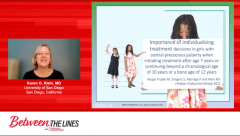
Vargas Trujillo CPP Study Review: Conclusion
Karen O. Klein, MD, leads a discussion of the Vargas Trujillo et al study on the importance of individualizing treatment decisions in girls with CPP, including factors that influence the decision to begin and cease treatment.
Episodes in this series
Karen O. Klein, MD: Hello. My name’s Dr Karen Klein from the University of California San Diego in San Diego, California. And I will be discussing a Journal Club article today. The title is “Importance of individualizing treatment decisions in girls with central precocious puberty when initiating treatment after age 7 years or continuing beyond a chronological age of 10 years or a bone age of 12 years.” The first author is Dr Marcela Vargas Trujillo, one of my colleagues at the University of California San Diego. This program is sponsored by AbbVie. I need to disclose that the contents are consistent with all applicable FDA guidelines. I’ve been selected by AbbVie, and I’m presenting on their behalf.
In the discussion of the paper, we talk about the rate of bone maturation slowing throughout treatment, which is known from other studies; the increase in predicted adult height continuing with longer duration. And then the key new findings are the predicted adult height increase in 91% of those who started treatment after a chronological age of 7 years. The girls who initiated treatment who were greater than 7 years of age had comparable predicted adult height increases, as well, and almost 85% of the girls who continued treatment after a bone age of 12 continued to have further increases in predicted adult height. Girls in this study reached a final height similar to the predicted adult height achieved during treatment. And all of this led to our conclusion that treatment decisions should be individualized. Initiation and cessation of treatment should not be based solely on bone age or chronological age alone. In our discussion, we included a few factors that influence that decision, if it’s an individualized decision. What are we thinking about when we’re deciding whether to start treatment? Well, girls with rapid progression of puberty have lower height outcomes than those with slow progression. Those with slow progression may not need treatment. Again, individualized. Further decrease in predicted adult height is due to the rapid bone maturation. If the bones are advanced, they’re going to continue to advance. The predicted adult height at the start of treatment, or when you’re considering treatment, is going to decrease from there, again, if they’re rapidly advancing.
Don’t base your decision on that one predicted adult height alone. And then predicted adult height compared to midparental height, of course, is important because genetics also plays a role in the growth potential of our children. The impending onset of menarche, of course, is a separate discussion not related to growth. But it’s a very important reason to start treatment in girls who might have their menarche at very young ages.
What about the other end of the spectrum, the factors influencing the decision to stop treatment? We want pubertal progression concurrent with peers once we’ve started treatment. We want to remember that bone maturation is going to accelerate post-treatment. If there was rapid acceleration of bones prior to treatment, whatever is causing that is going to resume once we stop treatment. Treatment pauses it, and then bone age accelerates again. And calculating predicted adult height has to consider that. We’ve already talked about, of course, that it matters how tall your family is. We’ve already talked about losing predicted adult height based on these factors. In general, it’s reasonable to continue treatment until predicted adult height is close to midparental height and growth is still reasonable. If growth velocity continues to slow down and chronological age is nearing bone age, and predicted adult height is not improving any further, then discontinuation of treatment is reasonable. If bone age indicates growth potential and predicted adult height is still improving, then even growth velocity alone might not dictate the cessation of treatment. Again, it’s important to individualize the decision with all these factors. A major part of the discussion in this publication is regarding the discussion of the Kaplowitz paper from 2018, which raised the issue of, in general, discontinuing treatment no later than a chronological age of 10 years. And many people have started to use that as sort of a guideline. They do talk in that paper about the rare cases of severe psychosocial stress, and very low predicted adult height. In the present study, the mean chronological age at the end of treatment was 11 and a half years of age, and predicted adult height had continued to improve a year prior to that. Stressing that there are some examples of when just basing discontinuation of treatment on chronological age alone maybe is not a good idea, once they’ve already had many years of treatment. For example, a girl with a chronological age of 10 years and a bone age of 10 has more growth potential than a girl with a chronological age of 10 years and a bone age of 12. This latter child might need to remain on treatment longer to continue to slow the rate of bone maturation and make up for the loss in predicted adult height—again, based partly on how tall they are and where we’re expecting them to be compared with their family. Two children, each age 10 but with different heights, might have different treatment plans, or different bone ages might have different treatment plans. Menses onset is also very important.
The Kaplowitz paper suggests that since menses occurs an average of 18 months after cessation of treatment, the girl who stops treatment at 10 years of age would have menses at an average of 11 and a half years, consistent with the general population. However, we raised the caution that this reasoning is based on the average of when menses occur, but we know that the range is from 3 months to 3 years. If someone is 10 years of age and had more rapid progression or later onset of treatment and is more likely to start menses sooner—maybe within 3 months—consider in the decision-making…whether that’s reasonable. Based on how she’s doing psychosocially, where she is with her peers, our goals that we want to reach, and her height. The Kaplowitz paper also discussed cost-effectiveness. Again, that needs to be individualized based on all these other factors, and this is not a major topic of the current paper. There’s the presentation of the Journal article. And in a Journal Club discussion, we always like to review the strengths and limitations—even if I wasn’t one of the authors. The strengths are that it’s actually a relatively large study for central precocious puberty. It’s not easy to do these studies, and it’s a very long-term follow-up in which we had lots of data and final height in many girls. The diversity of age at initiation of treatment helps us try to address some of these issues. And the rigorous criteria to define central precocious puberty meant that we had rapidly-progressing girls. When we look at some of the other studies in the literature, there’s a wide range of how many girls with slowly-progressing puberty, but their bone age wasn’t that advanced. They weren’t accelerating that rapidly. That affects how much benefit treatment has. And some studies are difficult to interpret, based on the diversity of patients. Limitations: There weren’t enough subjects for a prediction model of who benefits from continued treatment and who doesn’t. We still must put all those factors together. But it gives data to consider all those factors. And then the subgroup analyses that we did were too small for statistical testing. Again, they are just descriptive and are not definitive. And then we didn’t have parental heights in all the patients. Of course, that’s a limitation.
In conclusion, the variability in change of predicted adult height emphasizes the multifactorial influences on height and the importance of individualizing treatment decisions. The girls who initiated treatment after a chronological age of 7 years had improvements in predicted adult height similar to the younger girls. The continuation of treatment after a chronological age of 10 years or a bone age of 12 led to continued increase in predicted adult height in almost all girls. The initiation of treatment despite the chronological age greater than 7 years, and continuation of treatment after a bone age of 12 should be considered in some girls, with the aim of attaining optimal growth. Treatment decisions should be individualized, and initiation or cessation of treatment should not be based on bone age or chronological age alone. Thank you very much for your attention to the discussion of this publication.
Transcript Edited for Clarity
Newsletter
Access practical, evidence-based guidance to support better care for our youngest patients. Join our email list for the latest clinical updates.








